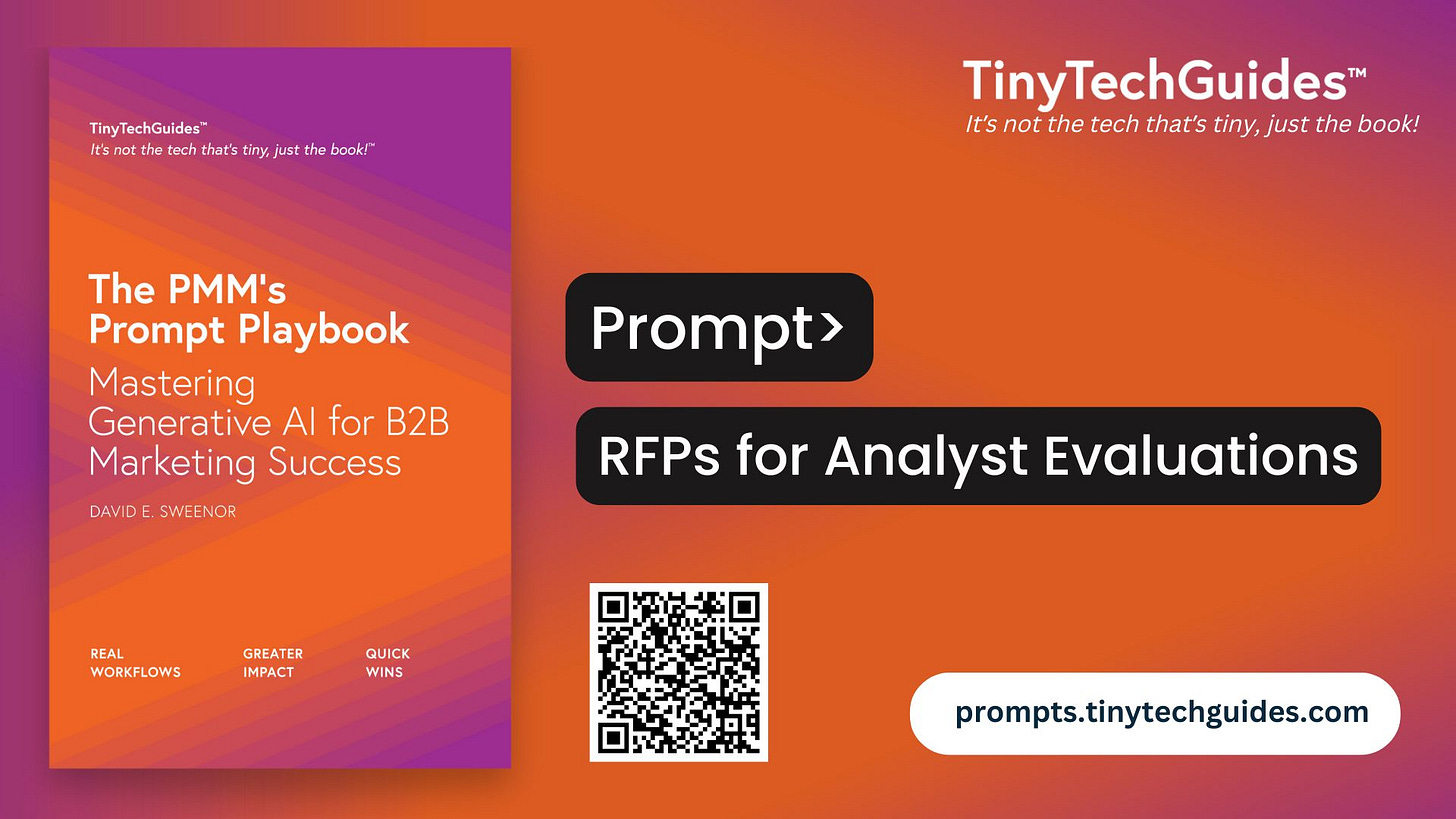How to Win at Analyst RFPs Without Losing Your Sanity
A repeatable process to map requirements, showcase differentiators, and strengthen market perception
Prompt Workflow: RFPs for Analyst Evaluations Workflow
Created by prompts.tinytechguides.com
What This Workflow Does
This workflow provides a structured, repeatable process for responding to analyst RFPs (like Gartner evaluations). It helps extract technical requirements, map them accurately to your product’s capabilities, fill in proof points, reuse prior RFP responses, and position your product clearly against competitors. It also ensures limitations are addressed transparently without losing momentum in the eval process.
Workflow Steps Summary
Step 0: Define Inputs
Step 1: Extract and Summarize the RFP Requirements
Step 2: Map Product Technical Details to RFP Requirements
Step 3: Address Gaps and Clarify Limitations
Step 4: Incorporate Responses from Previous RFPs
Step 5: Final Review and Optimization
Step 0: Define Inputs
{rfp_file} = Analyst RFP spreadsheet
{product_name} = Name of the product/solution
{product_docs} = Technical documentation (features, specs, integrations)
{previous_rfp_responses} = Previously completed RFPs
{key_differentiators} = What sets your product apart
{known_limitations} = Known feature gaps or deployment constraints
{proof_points} = Certifications, benchmarks, customer success metrics
Step 1: Extract and Summarize the RFP Requirements
#Role
You are a technical analyst summarizing the key technical requirements from the {rfp_file} into organized themes.
#Context
The RFP contains hundreds of rows. We need to extract technical requirements, categorize them into logical areas (like security, performance, integrations), and highlight any sections that are marked critical or heavily weighted.
#Task
Summarize the RFP requirements into organized categories to simplify mapping.
#Format
**High-level categories:**
Category 1: [E.g., Security]
■ Row 1: “Does the product comply with SOC 2 Type II standards?”
■ Row 12: “Is end-to-end encryption supported?”
Category 2: [E.g., Performance]
■ Row 33: “What is the data ingestion rate for real-time streams?”
■ Row 45: “Does the solution support sub-5ms latency for 100K events?”
**Critical sections:**
Highlight critical rows or weighted requirements:
[E.g., Rows 10–25 have a weighting of 30%]
#Tone
Clear, structured, and organized for further analysis.
Step 2: Map Product Technical Details to RFP Requirements
#Role
You are a technical content specialist mapping the product’s technical capabilities to the RFP requirements using {product_docs} and {previous_rfp_responses}.
#Context
Each row must be mapped to an accurate response, with product capabilities, proof points, and reusable standardized language.
#Task
For each technical requirement, provide:
• Mapped product capability
• Concise technical response
• Relevant proof point
• Gaps or limitations if applicable
#Format
**RFP Row | Requirement | Product Capability | Response | Proof Point | Gaps/Notes**
12 | “Does the product support SOC 2 Type II?” | Compliance Certifications | “Yes, {product_name} is SOC 2 Type II certified.” | Certification document available. | None
33 | “What is the data ingestion rate?” | Data Ingestion Performance | “Supports up to 10K events/sec with 2ms latency.” | Customer X benchmark | None
45 | “Integrates with AWS?” | Cloud Integrations | “Native AWS integrations with S3, Redshift, and Lambda.” | AWS Partnership Case Study | None
150 | “On-premise support?” | Deployment Models | “Supports both cloud and on-prem deployments.” | Customer Y deployment case | Requires tech verification
#Tone
Concise, accurate, and professional.
Step 3: Address Gaps and Clarify Limitations
#Role
You are a technical advisor identifying feature gaps and limitations in the RFP mapping process.
#Context
Some requirements may not be fully supported. We need to document them transparently, suggest alternatives, and maintain credibility.
#Task
Identify any RFP items that can't be directly met. Offer partial solutions or roadmap info where applicable.
#Format
**Feature gaps:**
Row: [E.g., 150]
Requirement: “Native Kubernetes support”
Current status: “Partial support through custom integrations”
Alternative response: “Native support is under development; current integration via standard APIs.”
**Limitations:**
Row: [E.g., 175]
Requirement: “Supports 1M concurrent users”
Current status: “Scales to 500K per deployment”
Clarification: “Scaling above 500K requires custom cluster setup.”
#Tone
Transparent, solution-focused, and professional.
Step 4: Incorporate Responses from Previous RFPs
Keep reading with a 7-day free trial
Subscribe to B2B Marketing Prompts by TinyTechGuides to keep reading this post and get 7 days of free access to the full post archives.


